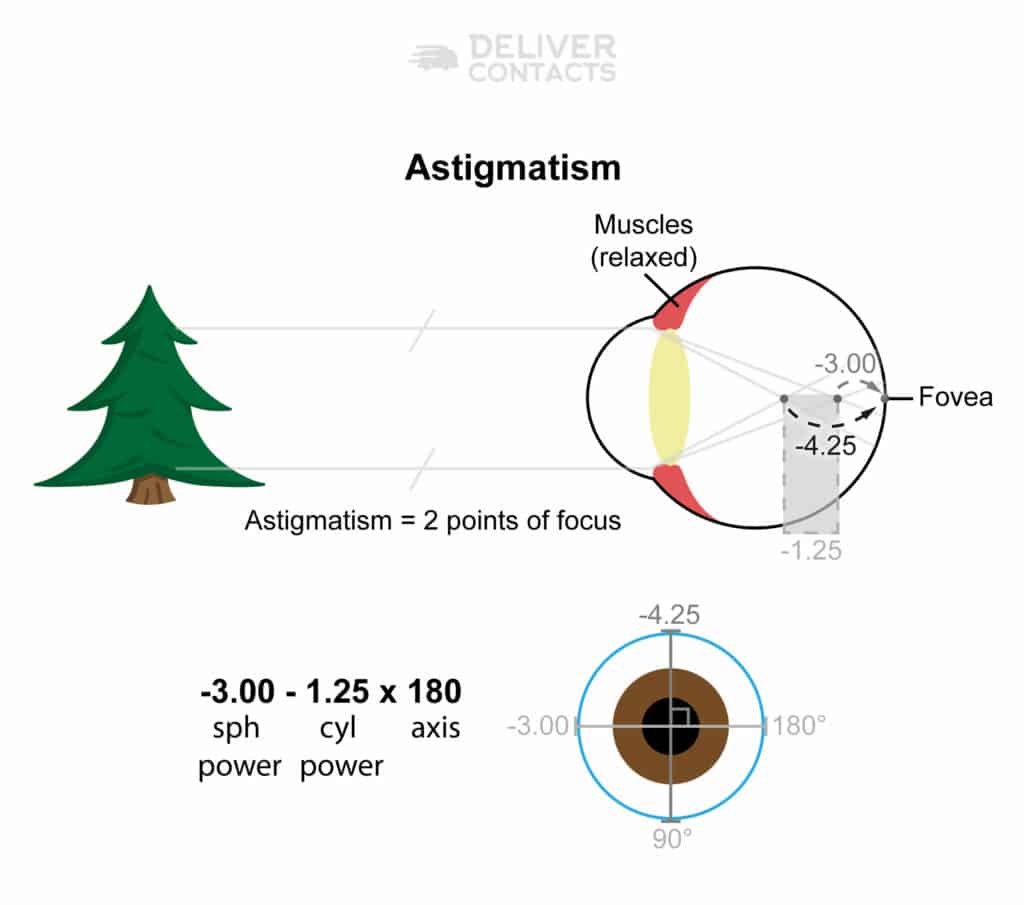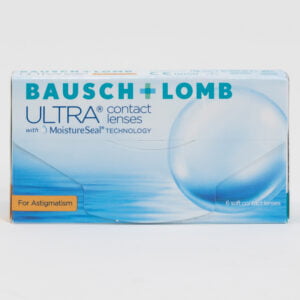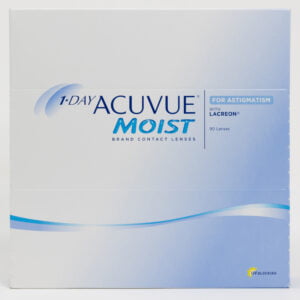Astigmatism: Definition, Causes, & Treatment
What is Astigmatism?
Astigmatism is an optical condition of the eye that causes vision to be blurry when looking at things that are either far away or up close due to having multiple points of focus.
Other refractive error problems (such as nearsightedness and farsightedness) are caused by light being focused to ONE POINT either in front of the fovea of the retina, or behind the fovea. Astigmatism, on the other hand, has TWO POINTS of focus that can be anywhere… in front of, on, or behind the fovea.
What determines how much astigmatism a person has is how far apart those two points are.

Astigmatism Explained (Video)
How Common is Astigmatism?
Astigmatism is very common, occurring in about one third of the population. The rate of astigmatism also increases as we age, up from 14.3% in people under 15 years old all the way up to 67.2% in those over 65. [1]
However, it’s important to note that there is a wide range in the severity of astigmatism that one can have.
Is Astigmatism Dangerous?
Astigmatism generally is just a word that is used to describe how optics focus in the eye. It is not a disease and doesn’t describe anything that is bad, it is just a reference on what needs to be done to get light onto the fovea.
Most people that wear glasses have at least some amount of astigmatism correction necessary.
The only time that astigmatism can create harm is when a child who has astigmatism and doesn’t get optically corrected during that important young period of visual and neuronal development, and amblyopia (a neuronal condition of limited visual acuity) occurs.
What Causes Astigmatism?
Astigmatism is hereditary. In fact, if either parent has astigmatism, then the odds are pretty strong that their children will too. There isn’t anything that you can naturally do to make it appear or prevent it from coming.
When the body grows, so does the eye. That is why children, especially during their greatest years of growth (8-16 years old) tend to have the greatest changes in their vision.
Many times, children are born with their astigmatism and may or may not grow out of it with the developing eye.
When light enters the eye, it is supposed to converge to focus at a pinpoint spot on the retina called the fovea. Astigmatism occurs when, instead of one point of focus, there are two separate points of focus in the back of one eye.
Sometimes, this precise focus of light on the fovea moves because of optical changes involving the shape or curvature of the cornea, or the lens of the eye.
The greater the separation of the two focal points, the greater the amount of astigmatism.
How is Astigmatism Treated?
Astigmatism correction requires moving both of the off focus points back to the fovea. This is done by creating a lens that has two prescriptions in it, oriented ninety degrees from each other to correct each point individually.
Glasses and contacts are the two most common ways to move the two points back to the fovea.
For example, if one point is at 3.00 millimeters in front of the fovea, and the other point is at 4.25 millimeters in front, then each point needs to be moved backward their respective distance to establish clear focus.
However, we wouldn’t use the terminology of “backward 3.00 millimeters”, instead, we would say “-3.00 diopters and -4.25 diopters”. Light is not measured in units of length, it is measured in diopters.
With astigmatism, the power that is needed to move the point that is the furthest away from the cornea is called the “sphere power” and the GAP between the two points is called the “Cylinder Power”.
Reading Astigmatism Prescriptions
Notice that the gap space in our example is 1.25D. Therefore, when reading this prescription, it begins with the sphere power, then the gap distance (the cylinder power) is noted, and then instructions on how to orient the two powers in the correcting lens are given by denoting the axis of the cylinder. Hence, an example of a prescription for these two mentioned points would look like this:
-3.00-1.25X180
The “X” indicates the axis of the cylinder. Therefore, the -3.00 would be oriented in a contact lens or glasses horizontally (at 180 degrees), and the -4.25 would be located vertically (at 90 degrees).
Popular Astigmatism Lenses
-
Product on sale
 ULTRA for Astigmatism (6 pack)Original price was: $69.75.$55.99Current price is: $55.99.
ULTRA for Astigmatism (6 pack)Original price was: $69.75.$55.99Current price is: $55.99. -
Product on sale
 Clariti 1 Day Toric (90 pack)Original price was: $92.50.$79.99Current price is: $79.99.
Clariti 1 Day Toric (90 pack)Original price was: $92.50.$79.99Current price is: $79.99. -
Product on sale
 1-Day Moist for Astigmatism (90-pack)Original price was: $105.50.$83.99Current price is: $83.99.
1-Day Moist for Astigmatism (90-pack)Original price was: $105.50.$83.99Current price is: $83.99.
Which Brand of Contact Lens Should be Used for Astigmatism?
All major contacts brands make lenses for the great majority of astigmatism patients.
For the few extreme cases where there are excessive amounts of astigmatism and atypical orientations of axes, Coopervison has a wider range of availability than the other companies.
We recommend daily disposable for safety and simplicity if your budget allows, but what will ultimately determine your choice of brand will likely be your lifestyle and your discussion with your eye doctor.
Once you have your prescription, shop online with us for the top brands at the lowest prices with free delivery.
Does Astigmatism mean that an Eye is Shaped Like a Football?
This is a common explanation and belief when it comes to astigmatism, but no. That doesn’t actually ever happen.
But let’s just say that an eye was shaped like a football, and even had the word WILSON tattooed on the side and laces… If this football looking eye only has one point of focus, then it does NOT have astigmatism.
Astigmatism means that there are two points of focus instead of one in the back of the eye, and it is not determined by what the eye looks like.
However, there is a reason that this explanation is given so often. The reason that the term “football shaped” is used is because when the clear dome (the cornea) that covers the color part (the iris) of our eye has two different curvatures (like a football is flatter long ways, and steeper circumferentially), the two curvatures may cause two different points of focus.
Often, the front of the cornea is what causes astigmatism, but not always. Sometimes it’s the back of the cornea, sometimes it may be the front or back of the crystalline lens behind the pupil, or maybe it’s a combination of all of those curves that may create the astigmatism. So there is a reason for the term “football shaped”, but if it is not qualified with an explanation, that explanation is likely to be misleading.
Should I Get Glasses or Contacts for Astigmatism?
If you have astigmatism, then you should either wear glasses or glasses in combination with contact lenses.
Contacts should always be worn along with the use of glasses. So, if you must get one or the other, get glasses first.
What are the Differences Between Glasses and Contact Lenses for Astigmatism?
Glasses tend to correct astigmatism more precisely than contact lenses because contact lenses have less of a range of powers and axes that they can utilize.
Also, contact lenses should not be worn exclusively, as they have inherent risks that can be avoided by letting the eye breathe. When you don’t have glasses, then you may not give your eye enough oxygen.
Wearing glasses or contacts doesn’t cause the eyes to get worse or better, they just move the focal points into position so the wearer can see again.
Glasses
With glasses, since there are two points that need to be focused, and different powers create different amounts of magnification and minification, then the two images that are focused on the fovea are going to be of different size.
At first, this will skew the appearance of the world, and perhaps make the floor seem tilted or make everything look squashed or stretched, until the brain adapts to the images and everything appears normal again.
Contacts
Since contacts sit directly on the eye, these magnification and minification effects will NOT occur and vision will not appear distorted. Also be aware that a glasses prescription and contact lens prescription for astigmatism will likely not look similar.
As a matter of fact, in your contact lens prescription, your doctor might not even include your astigmatism correction. I know this sounds odd, but it is actually very common given the cost, comfort, stability, and availability of contact lens options. In other words, find an eye doctor who you trust to determine your contact lens prescription and don’t be surprised if the scripts don’t even appear related.
Astigmatism FAQs
What is Astigmatism?
Astigmatism is an optical condition of the eye that causes vision to be blurry when looking at things that are either far away or up close due to having multiple points of focus.
How Common is Astigmatism?
Astigmatism is very common, occurring in about one third of the population.
Is Astigmatism Dangerous?
Generally, no. Astigmatism is not dangerous. The only time that astigmatism can create harm is when a child doesn’t get optically corrected during their development and amblyopia occurs.
Is Astigmatism Hereditary?
Yes, Astigmatism is hereditary. In fact, if either parent has astigmatism, then the odds are pretty strong that their children will too.
Can Astigmatism be Prevented?
Astigmatism is genetic. There isn’t anything that you can naturally do to make it appear or prevent it from coming.
How is Astigmatism Treated?
Astigmatism correction requires moving both of the off focus points back to the fovea. This is done by creating a lens that has two prescriptions in it, oriented ninety degrees from each other to correct each point individually. Typically, prescription glasses or contacts are used to treat astigmatism.
Does Astigmatism mean that an Eye is Shaped Like a Football?
This is a common explanation and belief when it comes to astigmatism, but no. The eye’s shape does not necessarily determine whether or not someone has astigmatism.
Should I Get Glasses or Contacts for Astigmatism?
If you have astigmatism, then you should either wear glasses or glasses in combination with contact lenses.
Deliver Contacts references research from industry experts and reputable industry publishers to support claims or data in our content when applicable.
- Optometrists Network - Astigmatism: Top 9 FAQs
Accessed: November 26, 2022
Need Consistanly Cheap Contacts?
DeliverContacts.com always guarantees you are paying low prices, every time you buy. We will never play games with our pricing or take part in manipulative discounts. Just consistently cheap contacts, forever.
Give your box a search below and see for yourself! 100% Free shipping and returns on all products!
Check out our most popular lenses
Get The Lowest Prices, Forever!
We will never send you junk or give out your information. The only emails you'll get from us are ones you be glad you got.



